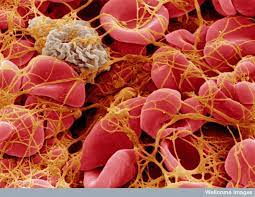الغاية من هذا المنشور أن نعرف كيف يتم التصرف في حال حدوث عرض نادر وهو الخثرات من نمط cvst بعد لقاحات مثل أسترازينيكا وجونسون اند جونسون وقد تحدثت عن ذلك كثيراً ولكن يوجد تحديث وسيتم التحديث بشكل مستمر على صفحتي عند ظهور اي معلومات جديدة
من المهم هو أن نكون على معرفة وعلم كيف نتصرف لأنه يمكن معالجتها إذا كان التدخل في الوقت المناسب وذلك بدل من إنكار وجود العرض النادر والإكتفاء بالقول أن “فوائد اللقاح تفوق المخاطر”
هنا لدينا عاملين أساسيين دور الشخص الذي اخذ اللقاح ودور الطبيب
أولاً دور الشخص:
هو مراقبة الأعراض التي قد تنذر بالتأثير الجانبي نادر الحدوث وهو الخثرات المترافقة مع انخفاض الصفيحات
ظهور أي من هذه الأعراض تستدعي مراجعة المشفى أي لايمكن أن تعالج بالمنزل لأنها تتطلب مراقبة طبية
ماهي الأعراض؟
تظهر خلال اليوم 5-28 بعد اللقاح
صداع شديد مستمر-يزيد سوءاً عند الإسلقاء او الغنحناء وقد يترافق مع غثيان وإقياء, صعوبة في التنفس- اضطراب في الرؤية- سعال- نزوف على شكل نقط حمراء صغيرة في غير مكان الحقن- تورم بالقدمين أو شعور أنها دافئة بشكل غير اعتيادي – الم بطني- اضطراب في الرؤية- إغماء
هل أخذ الجرعة الثانية إذا كنت تحت 40 عاماً؟
نعم. لمن أخذ الجرعة الأولى من لقاح أسترازينيكا فسيتطيع اخذ الجرعة الثانية من نفس اللقاح. بعض الدول مثل ألمانيا وكندا تلجأ حالياً لنظام إعطاء الجرعة الثانية من لقاح آخر
التجارب السريرية حول هذا الموضوع مستمرة في بريطانيا وقد قمت بنشر النتائج المبدئية منذ أيام (اضغط في الرابط)
اليوم نشرت دراسة في اسبانيا أن مزج لقاح فايزر وأسترازينيكا فعال وآمن حيث أن فعالية كانت أكبر عند اعطاء لقاح فايزر مع أسترازينكا بدلا من لقاح استرازينيكا لوحده
هل هناك توصيات باخذ نوع معين من المميعات مثل الأسبرين؟
لايوجد حالياً أي توصيات باخذ مميعات من نوع معين كما أن الهيئة الصحية البريطانية تنصح بعدم أخذ الأسبرين إلا إذا كان هو جزء من الأدوية التي يأخذها المريض بشكل روتيني
بالنسبة للقاح استرازينيكا أو جونسون اند جونسون, هل هناك مضاد استطباب بمعنى حالة مرضية لها علاقة بالتخثر تمنع اخذ اللقاح؟
بالنسبة للمرضى الذين لديهم سوابق مرضية لها علاقة بالتخثر فينصح دائما باستشارة الطبيب ولكن حالياً لايوجد توصيات تمنع الشخص من أخذ اللقاح إلا كان اصيب سابقاً بنوع من الخثرات المتعلقة بالهيبارين
لذا اؤكد على ضرورة استشارة الطبيب
أما علاج الخثرة فيجب ان يتم بالمشفى (الهيبارين مضاد استطباب)
- موضوع آخر قد يهمكم حول نسبة حدوث الخثرات ومقارنتها بين الكوفيد واللقاح وكذلك سبب تشكل الخثرات في الرابط
ثانياً: المتخصين:
فالمعلومات حول طريقة العلاج والتشخيص محدثة (بريطانيا وأميركا وهناك نشرة علمية أيضاً للإطلاع)
الخثرات النادرة التي قد تحدث عند بعض الأشخاص بسبب اللقاح ممكن معالجتها إذا تم تحديدها بشكل سريع
البروتوكول من قبل الهيئات المختصة في بريطانيا في الرابط , كنت وضعت ايضاً برتوكول الجمعية الأميريكية في الرابط , البارحة أيضاً نشرت الدراسة التالية في الرابط
Guidance from the Expert Haematology Panel on Covid-19 Vaccine-induced Immune Thrombocytopenia and Thrombosis (VITT), UK
April 20th 2021
DEFINITE CASE:
Cases usually present 5-28 days after vaccination and are characterized by thrombocytopenia, raised D Dimers, and thrombosis, which is often rapidly progressive.
There is a high preponderance of cerebral venous sinus thrombosis. Portal vein and splanchnic vein thrombosis, pulmonary embolism and arterial ischaemia are also common, as well as adrenal infarction and haemorrhage.
Intracranial haemorrhage can be significant and unexpected.
- Typical laboratory features include a platelet count <150 x109 /L, very raised D Dimer levels above the level expected for VTE and many develop low fibrinogen levels.
- Antibodies to platelet factor 4 (PF4) have been identified and so this has similarities to heparininduced thrombocytopenia (HIT), but in the absence of patient exposure to heparin treatment. PF4 antibodies are detected by ELISA HIT assay but not usually by other HIT assay methods.
POSSIBLE CASE:
Any patient presenting with acute thrombosis and new onset thrombocytopenia within 28 days of receiving COVID 19 vaccination
Investigations
- FBC- specifically to confirm thrombocytopenia <150x 109/L
- Coagulation screen, including Clauss fibrinogen and D Dimers
- Blood film to confirm true thrombocytopenia and identify alternative causes
Guidance from the Expert Haematology Panel (EHP) on
Covid-19 Vaccine-induced Immune Thrombocytopenia and Thrombosis (VITT)
UNLIKELY CASE:
- Reduced platelet count without thrombosis with D dimer at or near normal and normal fibrinogen.
- Thrombosis with normal platelet count and D dimer <2000 and normal fibrinogen
PROBABLE CASE:
- D Dimers > 4000 mcg/L (or D Dimers > 2000 with strong clinical suspicion)
- Send serum sample for PF4 antibody assay (ELISA HIT assay). Please see below *
- Ultrasound abdomen for portal and splanchnic vein thrombosis
- Look carefully for CVST, initial imaging may be negative but may be seen on subsequent imaging
Management of a Probable Case – Treat first while Awaiting Confirmatory Diagnosis:
- GIVE intravenous immunoglobulin urgently as this is the treatment most likely to influence the disease process. Give 1g/kg (divided into two days if needed), irrespective of the degree of thrombocytopenia, and review clinical course. Repeated IvIg may be required.
Steroids may also be helpful and although this is unknown, the benefit is likely to outweigh risks of harm.
- ANTICOAGULATE with non-heparin-based therapies such as DOACs, fondaparinux, danaparoid or argatraban depending on the clinical picture. Bleeding and thrombotic risk needs to be carefully balanced and low dose fondaparinux or critical illness dose argatroban may be appropriate while platelet count is <30 x109 /L .
- Plasma exchange may be considered if very severe or resistant disease. This may be required daily for up to 5 days if recovery is slow.
- Transfer patients with CVT to a centre with a neurosurgical unit and consider early recourse to neuroradiology and/or neurosurgery if deterioration/progressive bleed.
If urgent neurosurgery is required transfuse platelets to >100 x109/L and cryoprecipitate to maintain fibrinogen >1.5g/L.
- It is unclear whether platelet transfusions will exacerbate the condition, the risk/benefit in supporting patients with platelets <50 x109/L on anticoagulation who have a secondary cerebral bleed and not requiring procedures is unknown and therefore clear advice cannot be given at present.
- It is unknown whether heparin exacerbates the condition but until further evidence is available, as the syndrome mimics HIT,heparin is best avoided, including hepsal flushes.
- Replace fibrinogen if needed, to ensure level does not drop below 1.5 g/L, using fibrinogen concentrate or cryoprecipitate
- If no overt thrombosis, but thrombocytopenia with raised D Dimer, thromboprophylaxis with nonheparin-based anticoagulants should be considered – balancing bleeding and thrombotic risk. DOAC, fondaparinux or danaparoid can be used.
- For patients who are refractory to repeat doses of IVIg and Plasma exchange, Rituxmab can be considered although there is no evidence of its efficacy in VITT at present.
DEFINITE CASE
If PF4 antibodies positive by ELISA:
- Continue ongoing treatment as above
- Send serum sample to Colindale for Covid-19 antibody testing and storage*
- Send EDTA sample for whole genome sequencing
If there is a high index of clinical suspicion but PF4 antibodies are negative, please send serum and EDTA anyway and discuss before changing treatment.
Discharge:
Close follow-up is required, with regular platelet counts and assessment of symptoms. A fall in platelet count or rising D-dimers should be treated with further IvIg.
Continue anticoagulation for at least 3 months, and before discontinuing anticoagulation ensure platelet count, D-dimer and fibrinogen are normal and PF4 antibodies negative.
If thrombosis was only arterial, once D Dimers, platelets and fibrinogen have returned to normal, the patient can be switched to an antiplatelet agent and continued for 3 months. Monitor platelet count closely to observe for relapse and consider repeating PF4 ELISA at day 28 from presentation.
Additional themes/learning points from the daily meetings:
- If coronary artery thrombosis or other arterial thrombosis occurs in healthy (not atherosclerosed) vessels, anticoagulation is required (potentially in addition to antiplatelet agents) for at least a month and the fibrinogen, D Dimers and platelet count must have remained normal after initial therapy. Thereafter it may be appropriate to switch to antiplatelet agents however consideration must be given to the lack of evidence, the potential risk of relapse and the individual characteristics of the patient.
- Argatroban levels ideally should be monitored by a Direct Thrombin inhibitor assay, if available, e.g. HEMOCLOT as APTT correlates poorly with the argatroban effect due to the high levels of Factor VIII.
- Switch to fondaparinux or a direct oral anticoagulant, as soon as the bleeding risk is considered to have reduced, given that these patients are highly prothrombotic and argatroban monitoring results may not reflect therapeutic anticoagulation.
- Some Clauss fibrinogen assays may give falsely low fibrinogen results during concurrent use of argatroban. Assays that use high concentrations of thrombin e.g. 100 UNIH/ml may be more accurate.

